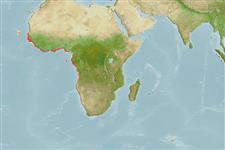Common names from other countries
Environment: milieu / climate zone / depth range / distribution range
Ecología
; rango de profundidad 0 - 90 m (Ref. 435), usually 4 - 40 m (Ref. 435). Tropical; 17°N - 19°S, 25°W - 14°E
Distribución
Países | Áreas FAO | Ecosistemas | Ocurrencias, apariciones | Introducciones
Eastern Atlantic: Western African coast from Mauritania to Namibia.
Length at first maturity / Tamaño / Peso / Age
Maturity: Lm ? range ? - ? cm Max length : 10.8 cm CW macho / no sexado; (Ref. 435)
Occurs at depths from shore to 90 m (Refs. 435, 2708); common at depths of 4 to 40 m. Burrows in sand or fine gravel and also in bottoms with other sediments. (Ref. 435). Can live on all level substrates but may prefer sand (Ref. 2708). In general, Calappa feeds upon molluscs and hermit crabs in gastropod shells. Their right claw is used for crushing shells of prey while their left claw is used as a cutter (Ref. 105092).
Life cycle and mating behavior
Madurez | Reproducción | Puesta | Huevos | Fecundidad | Larva
Members of the order Decapoda are mostly gonochoric. Mating behavior: Precopulatory courtship ritual is common (through olfactory and tactile cues); usually indirect sperm transfer.
Fischer, W., G. Bianchi and W.B. Scott (eds.). 1981. (Ref. 435)
IUCN Red List Status (Ref. 130435)
CITES status (Ref. 108899)
Not Evaluated
Not Evaluated
Threat to humans
Harmless
Human uses
Pesquerías: comercial
| FishSource |
Herramientas
Más información
Age/SizeCrecimientoLength-weightLength-lengthMorfologíaLarvaAbundancia
Fuentes de Internet
Estimates based on models
Preferred temperature
(Ref.
115969): 21.7 - 28, mean 26.2 (based on 116 cells).
Vulnerability
Low vulnerability (10 of 100).
Price category
Unknown.
